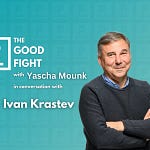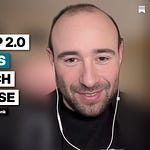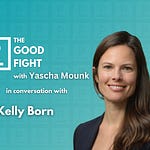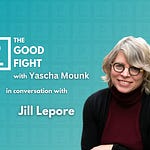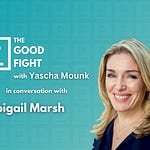Patrick Sharkey spent years studying the causes of the national decline in crime that took place from the 1990s to the 2010s. A professor of sociology and public affairs at Princeton and the author of Uneasy Peace: The Great Crime Decline, the Renewal of City Life, and the Next War on Violence, he warned that it would prove unsustainable to rely on aggressive policing and mass incarceration to keep the peace in America’s cities. Now, he is ideally placed to answer why violent crime has surged in the past year and what to do about that.
In this week’s conversation, Patrick Sharkey and Yascha Mounk discuss the recent rise in violent crime, how this trend hits disadvantaged communities the hardest, and why neither defunding the police nor returning to the old model of keeping the peace offers a real solution.
This transcript has been condensed and lightly edited for clarity.
Yascha Mounk: There’s been a lot of public debate in the last weeks and months about whether the great decline in crime that the United States has experienced for decades since the early 1990s or so has stalled, and whether we’re even perhaps at the beginning of a real surge in crime. What is your sense of the data?
Patrick Sharkey: Too many criminologists have been burned by forecasting into the future. And one thing we know is that violence is just this incredibly complex phenomenon—there’s no single factor that causes it. When factors change, it doesn’t necessarily mean [rates of] violence change.
From 1991 to 2014, violence was cut in half across the country, and in lots of cities it fell by 75, 80, [or] 85%. 2014 was one of the safest years in the history of the U.S.; the murder rate was 4.4 per 100,000. And since then, violence has been rising. It had been rising very gradually since 2014, until last year, when violence skyrocketed. The murder rate [for 2020] will probably have risen somewhere between 25% and 30%. So we’re going to be up over six murders for every 100,000 people, [which] is definitely the most violent year of this century, so far. And now it has continued into 2021.
The crime drop [since the 1990s] was particularly pronounced in cities: Los Angeles, New York, San Francisco, Minneapolis. Similarly, this spike last year hit a small number of cities particularly hard. And there are several cities where the number of fatal shootings rose by 60, 70, [or] 80% last year. That’s continuing into 2021. I'm following the data very closely. The real question is whether last year [was] an aberration, or whether it was the start of a longer-term period of rising violence.
Mounk: What do we know about the ways in which this may have been caused by the pandemic? Or do we really need to look for other factors?
Sharkey: It wasn’t just the suffering that came about because of the pandemic, and it wasn’t just people being locked down. It was [also] the breakdown of social institutions that bring us together and that provide the foundation for every community across the country. I’m talking about schools, but also libraries and parks and playgrounds. Those public spaces were shut down, in addition to community centers, after-school programs and summer jobs programs, and so forth. Those sorts of institutions provide the foundation for social order, and when those institutions shut down, people retreat to their homes. It doesn’t make every community more violent, but it makes every community more vulnerable to violence. When public spaces are abandoned, and institutions start to shut down, it creates the possibility for violence to emerge. So I think that was the starting point. [But] we didn’t see the explosion of violence until later in the year. That gives us a hint that it wasn’t all about the pandemic.
First, you had the pandemic and lockdown. While that was going on, we had this incredible increase in gun ownership and gun sales in the background, a record-breaking year in terms of gun sales. There is some new evidence (or at least hints of evidence) that those guns were circulating [on] the streets early in the pandemic. Jens Ludwig, maybe the best criminologist in the world, who runs the Chicago Crime Lab, put out an analysis [recently] showing that there was an increase in the number of people who were stopped and were carrying a gun in Chicago as early as March and April. And then you have the protests in late May, after George Floyd was murdered, and the reaction to it and the set of processes that that generates, which includes changes in police behavior, but also changes in residents’ behavior. And that’s when violence really started skyrocketing in lots of cities across the country.
When I look at last year, lots of people are still gathering data. These are all hypotheses right now. But [at] my lab at Princeton, we’ve started making some progress toward an [...] explanation. It’s leading me to this idea that there’s a confluence of three stages, or three sets of factors: (1) the pandemic, the breakdown of social institutions; (2) the rise in guns, circulating guns; and then (3) the reaction to the protests, creating [an] overall feeling—which was partly around the election and the attack on the Capitol on January 6—that the social fabric was breaking down, and everybody’s on their own to deal with this set of crises.
Mounk: You mentioned the murder of George Floyd and the protests that ensued. [There are] a few different ideas floating around about how that might have helped to provoke a rise in violence. One of them, which is commonly cited on the political right, is that calls for defunding the police and, perhaps even more broadly, police accountability have led to a kind of pullback by the police. Then there’s a second idea, which is [of] residents of neighborhoods cooperating with police less because police misconduct is more salient to them than it was a few months earlier. How do you weigh these factors, or is trying to weigh them against each other too short-sighted?
Sharkey: I think you’ve hit on both sets of processes that play out and that are not just limited to protests around racial injustice last year, but that have been documented in other high-profile protests against police violence, police brutality, racial injustice in the criminal legal system—including the protests around Michael Brown and Freddie Gray. A set of processes often takes place after these kinds of protests. One, as you mentioned, is that the police can change their behavior. And that can be happening because of a change in policy. They can shut down specific units within police departments. It can happen because police officers are legitimately worried about becoming the next viral video, about taking the abuse that might come with getting involved in an incident that they don’t have to get involved [in]. And police can also step back to make a statement, and that definitely happens. There’s very clear evidence of particular places and times where that has happened. So it’s not beyond the realm of possibility that if the police feel offended by large-scale protests, then they will decide to stop doing their job—or at least, when they have discretion, choose not to get involved in an incident that they otherwise might.
The second set of processes is also particularly important here, [which] involves residents and how they interact not just with the police, but with the city more generally. We have pretty good evidence that in the aftermath of these kinds of incidents, [like] protests, residents sometimes “check out.” Residents sometimes make the case: “Hey, if I’m not a valued member of this community, I’m not going to talk to the police. I’m not going to call the police. I’m not going to give information. I’m going to check out [and] do my own thing.” It’s a phenomenon that’s often left out of these discussions. When you have the police [and residents] changing their behavior in a community where we haven’t funded other institutions to step up and play a central role in trying to combat violence and trying to make sure everybody’s safe and that these public spaces are cared for; when you have a social order that relies on the police dominating public spaces and the residents working with them, and then both sets of actors step back and say, “I’m no longer going along with this”—that creates the potential for those spaces to explode. It doesn’t always happen. But this past year, it happened in lots of cities across the country. And when you look at the trends, the timing is crystal clear: It happened at the end of May.
Mounk: Your long-standing work, and particularly the book Uneasy Peace, predicted this moment in two important ways. It predicted that policing is a really important determinant of crime, [and] that it really does help to keep down crime if you have a heavy police presence. But it also predicted the ways in which that [presence] disrupts neighborhoods and often mistreats individuals and may lead to a kind of rebellion against it. Tell us a little bit about the argument of why the peace that we had until 2014, the relative peace, was so uneasy. If we can’t just go back to where we were, where can we go?
Sharkey: The reason I called the book Uneasy Peace is because we hadn’t solved the larger challenge of extreme urban inequality and all of the problems and challenges that come bundled when you have extreme inequality. By this I mean segregation, [and] how segregation then translates into vastly unequal resources across communities and vastly unequal institutions across communities—concentrated poverty, extreme housing unaffordability, and [the] severe cost burden that is often concentrated in particular communities: addiction, mental illness, homelessness, and circulation of guns.
I make the case in the book that the model that we developed in the U.S. to deal with that was to abandon central-city neighborhoods—not try to solve those problems—and instead invest in [and] rely on the police and the prison system to deal with all of that. I think that model has been very stable since the late 1960s, when we first set along that path, and Daniel Patrick Moynihan announced the policy of “benign neglect” to deal with the problems of central cities. Even though there have been investments over time, there have not been sustained investments to deal with urban inequality.
The police are effective at controlling violence, but it also generates all these costs: anger and resentment. And that anger and resentment grew as more and more people saw what was happening in low-income communities of color, or how law enforcement was interacting with residents. It generally generates a feeling of legal estrangement: feeling like one is not protected by the law, or one is not part of the citizenry of a city. And it also generates costs that are more tangible, in the sense of mass incarceration. Our incarceration rate had been stable throughout the history of the country until the start of the 1970s. It increased by 700% from the 1970s to 2010. The impact of that on families and communities is only starting to reveal itself, because it doesn’t just affect the people who are incarcerated. It affects their entire networks, their families, and the next generation.
Mounk: Where does urban regeneration fit in with this idea of benign neglect?
Sharkey: I’m making the case that from [the 1960s] onwards, the overall argument has been “Okay, we’re not going to invest in core institutions of urban life. Instead, we’re going to reduce funding.” And that meant political influence fell for central cities as the suburban population expanded. It meant that core investments in housing were pulled back. Central cities’ share of state and federal budgets started to fall pretty substantially in that period and never recovered. That’s what I mean by “abandonment.” And then the punishment piece is investing in the police and the prison. Beginning in the 1990s, when violence fell, cities came back to life. The subtitle of the book is “The Renewal of City Life and the Great Crime Decline.” I don’t attribute the changes that occurred in the 1990s to a renewed federal investment in central cities. It was some of that, [but] I think it’s mostly come in the form of temporary investments. Over time, the renewal of city life came about because violence fell very clearly. Washington, D.C. is a great example. [It] used to be the murder capital of the U.S.; it had the highest rate of murder in the U.S. in the 1980s. [Then] homicides fell by 80%. This resurgence of cities—I point to the crime drop as causing it. When D.C. became seen as a place that was not as dangerous, it started to become seen as a place where you can invest. It happened in D.C., Boston, [and] New York. The places that started to reemerge were the places where violence plummeted.
Mounk: How worried should we be about these areas getting into trouble again in the next decades?
Sharkey: We should be very worried about it. I have started to think about violence as the fundamental challenge of cities, because the very idea of city life doesn’t work if public spaces carry the threat of violence. Cities are places where people share space. That idea breaks down when public spaces are unsafe. And by the way, this is not a story about whether you and I are going to continue to live in D.C.; it’s not about us. The crime drop had its biggest impact on the most disadvantaged communities and most disadvantaged segments of the population. So if you care about inequality, then I make the case that you have to first focus on violence. Nothing about a city will work, no investments will work in the downtown, if people are scared to live there, if people don’t want to raise their families there, if teachers don’t want to teach there, if businesses don’t want to open up shop in a community. I think we should be very worried about it.
Mounk: We see in opinion polls that a majority of Americans [and] also a majority of African Americans want the same amount or more police on the streets of neighborhoods, rather than less, which helps to explain the popularity of somebody like Eric Adams. Of course, this is a really crummy choice that people will have to make [between higher crime and the “uneasy peace" you describe]. They would like real public investment; they would like a police force that is much less militarized, that engages in much less misconduct. I’m not saying that this is an acceptable choice, but does it not suggest that the uneasy peace may last a lot longer than we’re thinking right now?
Sharkey: That has been the way the choice is framed. And I think that’s the way that policymakers and a lot of residents of central cities think about the choice in front of them. What I try to emphasize is that we know what that choice entails. We can reduce violence with that approach [increased policing], but it’s going to come with huge costs.
Police departments can shift their focus to build trust and legitimacy without sacrificing [public safety]. In New York, they ended the practice of “stop, question, and frisk,” and violence kept falling and falling and falling. So, police departments can do their job much better and make progress toward the same model, but one that comes without the worst abuses of power.
What I try to emphasize is that there is another model in front of us. It is a model that is not just a progressive’s view of how the world should be, but one that’s based on extremely rigorous evidence on how to deal with violence without the costs that come from police brutality or mass incarceration. We now have decades of evidence from lots of really good ethnography work on the ground, causal analysis, and randomized control trials, telling us that [we need to] invest in core community organizations to provide high-quality after-school programs, to provide better lighting around housing developments, to clean up abandoned lots and restore abandoned buildings. Business Improvement Districts have a causal effect on violence. All of these kinds of programs, when you invest in them—and when people know that that organization is going to be here in 10 years [and] the leadership is compensated for doing really high-quality work—make a neighborhood stronger and make a neighborhood safer.
Mounk: What you’re saying is, there is a better paradigm available. And that paradigm, from what I hear, has three components: You do continue to have police dominating public space, to some extent, at least in a transitional period; you take effective action against police misconduct in such a way that injustice is much lower; and you actually make all of this public investment to improve those neighborhoods over time. Are there other elements of this model that I'm missing?
Sharkey: No, that’s right. I think it starts with building other institutions that should play a central role in creating safer and stronger neighborhoods, and that we know can play a central role, but have been outside of the discussions about how to deal with violence. Now is not the time to pull back police forces. Without another institution that can step in, you’re going to create [more violence]. The reaction of “Okay, let’s dismantle police departments” is entirely justified based on what people saw during the pandemic [and] during the protests, and over the past five years when police killings haven’t fallen at all. But it’s going to create more violence if you do that, because it’s going to leave communities without any institution that sees it as a central responsibility to make sure violence doesn’t emerge. You laid it out nicely. The key component is to start investing in a new model, a new set of institutions to build stronger neighborhoods. We’ve got lots of evidence that that’s very possible. We've got evidence that it’s at least as effective as investing in the police, and it comes without the staggering costs—and they are staggering—of putting a generation of black Americans into the prison system, which is what we’ve done.
Mounk: How does that help to explain the fate of black America today? It seems to me, and this may be too simple a view, that there’s a real bifurcation within the African American community, that there are people who are living in the most disadvantaged neighborhoods in poverty, and that they have not made much progress on many socioeconomic indicators over the last five decades or so. When you go to the parts of Baltimore [or] the parts of Minneapolis that remain truly disadvantaged, it is a very bleak picture. At the same time, it seems as though the percentage of African Americans who in fact live in those truly disadvantaged neighborhoods has reduced over time, and perhaps is continuing to reduce, so that you see a greater share of African Americans living in integrated neighborhoods [as well as] a greater share of African Americans living in partially segregated but more affluent neighborhoods. How should we think about the overall picture in light of these components?
Sharkey: I think you’re exactly right. When we think about the issue of racial inequality in the U.S., it is rooted in communities. I did a study where we just looked at how racial inequalities in neighborhood environments have changed over time. There’s been huge change over the past 50 years or so. As civil rights expanded—and it no longer became legal to discriminate against black Americans—the middle class, black middle class, has started to move out into more affluent communities [and] more integrated communities. That’s been the only pathway toward reducing racial inequality in neighborhoods. Essentially, the only explanation for declining racial inequality has happened through families moving out. It has not happened in majority-black neighborhoods.
Mounk: How is it that you put the different pieces of this puzzle together trying to create a policy that fights crime energetically?
Sharkey: Honestly, the proposals on the table right now are not far from the proposals that I would put forth. President Biden put out a crime plan [on June 24] that’s not perfect, but touches on a lot of the areas that I think are central. We need to deal with the problem of violence through large-scale investment and mobilization. That’s the same answer for how we deal with COVID, for how we deal with climate change, for how we deal with suicide, for how we deal with the opioid epidemic: It comes through large-scale investment and mobilization. In this country we’re not particularly good at solving big challenges that require large-scale investment and mobilization. We need to invest in core community institutions—these are the investments that are being proposed in the jobs plan, like $5 billion for anti-violence organizations. It would be the first federal commitment at this scale to those kinds of organizations. It’s not enough, but it would have a huge impact. I think the Recovery Act back in 2009 had a huge impact. It doesn’t get the credit that it deserves. We need large-scale investments that hit every community across the country.
Mounk: What are some of the kinds of worlds that we might end up in a few decades from now?
Sharkey: Depending on the investments that are on the table right now, whether any of these proposals go through and at what scale, [the present moment] could be an aberration. This could be a moment where the conditions of last year calm down, and investments come into communities, stabilize cities, make sure city budgets don’t drop, make sure community organizations are funded and can go out and deal with the crisis that’s happening right now. So one scenario is that things stabilize because of investment. What comes after that will [probably] depend on who’s in power in 2022, and beyond.
Mounk: What are some of the more pessimistic scenarios if these community investments don’t quite have the impact [you hope for], or they simply can’t get through Congress?
Sharkey: The worst-case scenario, in my mind, is the current situation reinforced. And by that I mean failing to acknowledge and deal with and make the investments that are needed, and instead just turning back to the police and the prison system, failing to deal with our system of spatial inequality and allowing it to be amplified and reinforced through policy, allowing the political division that is mapped onto space [to] become solidified over time. That’s where we've been heading for a while. Without intervention, that’s probably where we're going to continue to head.
Please do listen and spread the word about The Good Fight.
If you have not yet signed up for our podcast, please do so now by following this link on your phone.
Email: podcast@persuasion.community
Website: http://www.persuasion.community
Podcast production by John T. Williams and Brendan Ruberry
Connect with us!
Twitter: @Yascha_Mounk & @JoinPersuasion
Youtube: Yascha Mounk
LinkedIn: Persuasion Community






